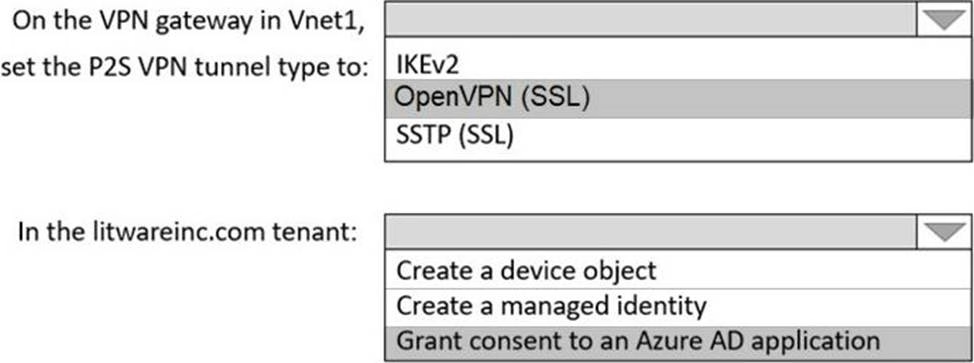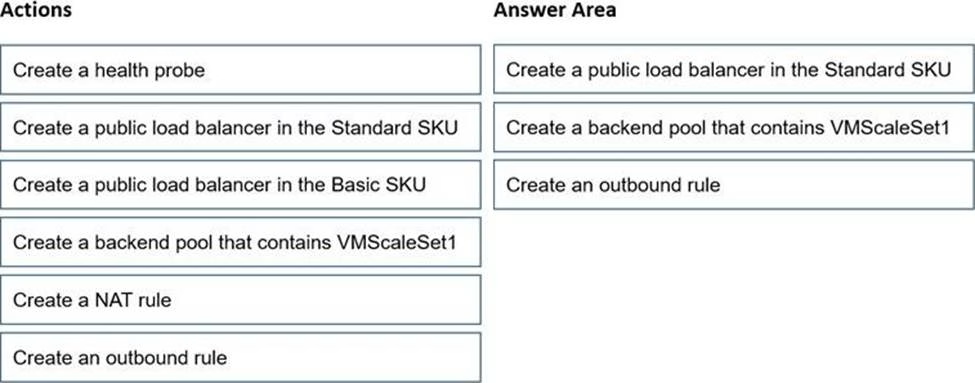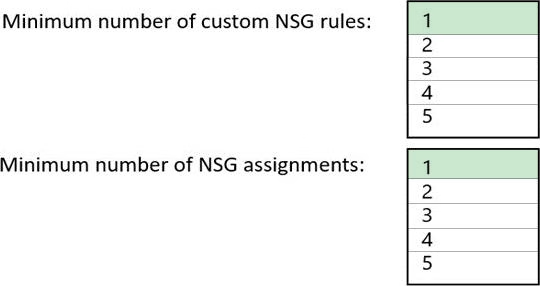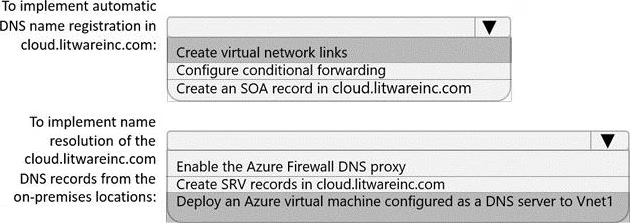Microsoft AZ-700 Designing and Implementing Microsoft Azure Networking Solutions Online Training
Microsoft AZ-700 Online Training
The questions for AZ-700 were last updated at Dec 15,2025.
- Exam Code: AZ-700
- Exam Name: Designing and Implementing Microsoft Azure Networking Solutions
- Certification Provider: Microsoft
- Latest update: Dec 15,2025
Topic 1, Litware. Inc Case Study 1
Overview
Litware. Inc. is a financial company that has a main datacenter in Boston and 20 branch offices across the United States. Users have Android, iOS, and Windows 10 devices.
Existing Environment:
Hybrid Environment
The on-prernises network contains an Active Directory forest named litwareinc.com that syncs to an Azure Active Directory (Azure AD) tenant named litwareinc.com by usinq Azure AD Connect.
All the offices connect to a virtual network named Vnetl by using a Site-to-Site VPN connection.
Azure Environment
Litware has an Azure subscription named Sub1 that is linked to the litwareinc.com Azure AD tenant.
Sub1 contains resources in the East US Azure region as shown in the following table.
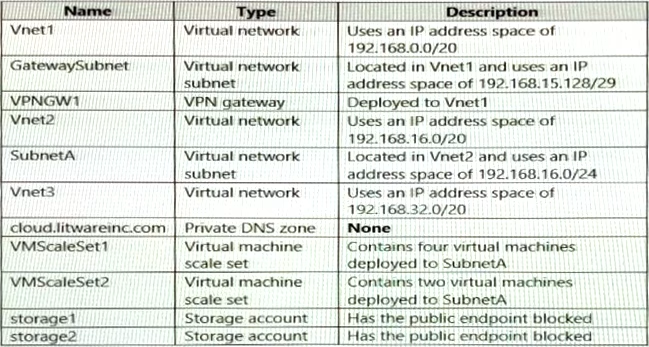
There is bidirectional peering between Vnet1 and Vnet2. There is bidirectional peering between Vnet1 and Vnet3. Currently, Vnet2 and Vnet3 cannot communicate directly.
Requirements:
Business Requirements
Litware wants to minimize costs whenever possible, as long as all other requirements are met.
Virtual Networking Requirements
Litware identifies the following virtual networking requirements:
* Direct the default route of 0.0.0.0/0 on Vnet2 and Vnet3 to the Boston datacenter over an ExpressRoute circuit.
* Ensure that the records in the cloud.litwareinc.com zone can be resolved from the on-premises locations.
* Automatically register the DNS names of Azure virtual machines to the cloud.litwareinc.com zone.
* Minimize the size of the subnets allocated to platform-managed services.
* Allow traffic from VMScaleSet1 to VMScaleSet2 on the TCP port 443 only.
Hybrid Networking Requirements
Litware identifies the following hybrid networking requirements:
* Users must be able to connect to Vnet1 by using a Point-to-Site (P2S) VPN when working remotely. Connections must be authenticated by Azure AD.
* Latency of the traffic between the Boston datacenter and all the virtual networks must be minimized.
* The Boston datacenter must connect to the Azure virtual networks by using an ExpressRoute FastPath connection.
* Traffic between Vnet2 and Vnet3 must be routed through Vnet1.
PaaS Networking Requirements
Litware identifies the following networking requirements for platform as a service (PaaS):
* The storage1 account must be accessible from all on-premises locations without exposing the public endpoint of storage1.
* The storage2 account must be accessible from Vnet2 and Vnet3 without exposing the public endpoint of storage2.
You need to connect Vnet2 and Vnet3. The solution must meet the virtual networking requirements and the business requirements.
Which two actions should you include in the solution? Each correct answer presents part of the solution. NOTE: Each correct selection is worth one point.
- A . On the peerings from Vnet2 and Vnet3, select Use remote gateways.
- B . On the peering from Vnet1, select Allow forwarded traffic.
- C . On the peering from Vnet1, select Use remote gateways.
- D . On the peering from Vnet1, select Allow gateway transit.
- E . On the peerings from Vnet2 and Vnet3, select Allow gateway transit.
DRAG DROP
You need to prepare Vnet1 for the deployment of an ExpressRoute gateway. The solution must meet the hybrid connectivity requirements and the business requirements.
Which three actions should you perform in sequence for Vnet1? To answer, move the appropriate actions from the list of actions to the answer area and arrange them in the correct order.

HOTSPOT
You need to implement a P2S VPN for the users in the branch office. The solution must meet the hybrid networking requirements.
What should you do? To answer, select the appropriate options in the answer area. NOTE: Each correct selection is worth one point.
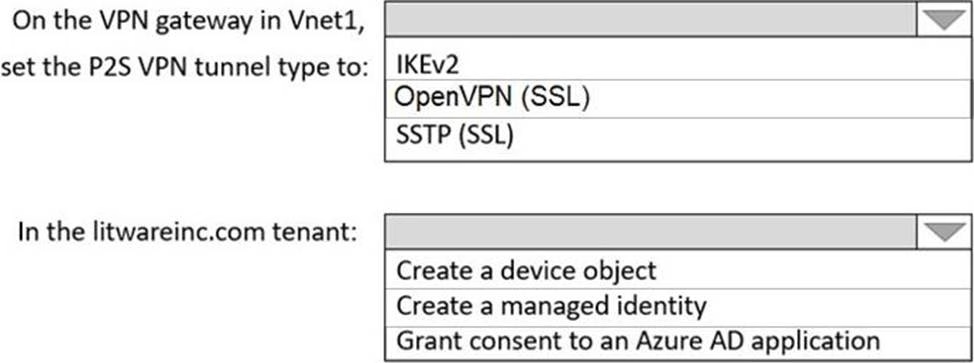
You need to provide connectivity to storage1. The solution must meet the PaaS networking requirements and the business requirements.
What should you include in the solution?
- A . a service endpoint
- B . Azure Front Door
- C . a private endpoint
- D . Azure Traffic Manager
HOTSPOT
You need to recommend a configuration for the ExpressRoute connection from the Boston datacenter. The solution must meet the hybrid networking requirements and business requirements.
What should you recommend? To answer, select the appropriate options in the answer area. NOTE: Each correct selection is worth one point.

DRAG DROP
You need to implement outbound connectivity for VMScaleSet1. The solution must meet the virtual networking requirements and the business requirements.
Which three actions should you perform in sequence? To answer, move the appropriate actions from the list of actions to the answer area and arrange them in the correct order. T
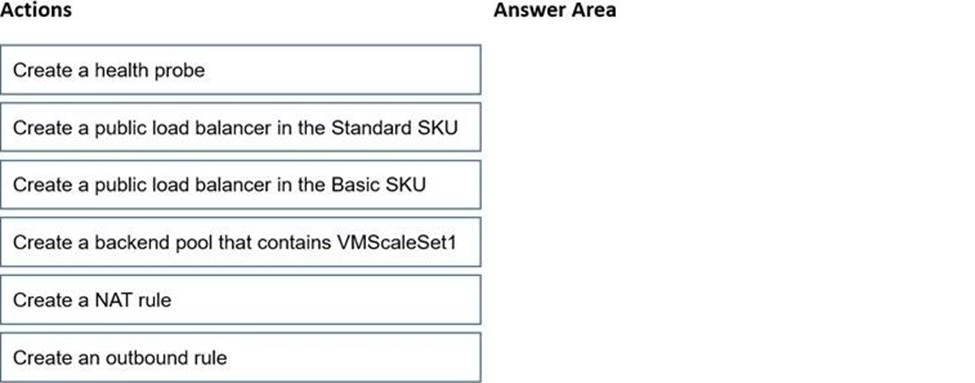
You need to configure the default route in Vnet2 and Vnet3. The solution must meet the virtual networking requirements.
What should you use to configure the default route?
- A . a user-defined route assigned to GatewaySubnet in Vnet2 and Vnet3
- B . a user-defined route assigned to GatewaySubnet in Vnet1
- C . BGP route exchange
- D . route filters
HOTSPOT
You need to restrict traffic from VMScaleSet1 to VMScaleSet2. The solution must meet the virtual networking requirements.
What is the minimum number of custom NSG rules and NSG assignments required? To answer, select the appropriate options in the answer area. NOTE: Each correct selection is worth one point.
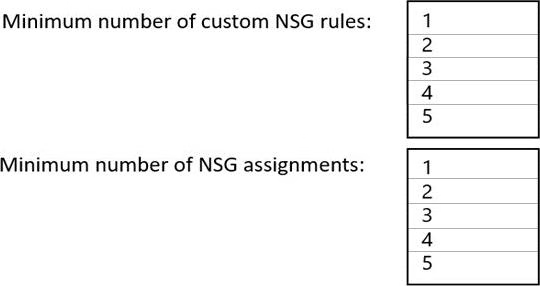
HOTSPOT
You need to implement name resolution for the cloud.liwareinc.com. The solution must meet the networking requirements.
What should you do? To answer, select the appropriate options in the answer area. NOTE: Each correct selection is worth one point.
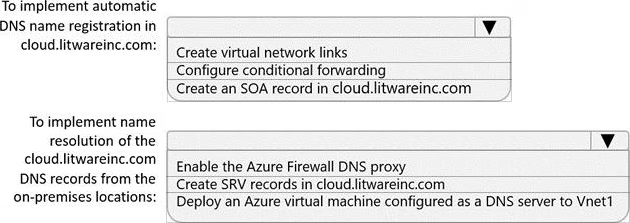
You need to configure the default route on Vnet2 and Vnet3. The solution must meet the virtual networking requirements.
What should you use to configure the default route?
- A . route filters
- B . BGP route exchange
- C . a user-defined route assigned to GatewaySubnet in Vnet1
- D . a user-defined route assigned to GatewaySubnet in Vnet2 and Vnet3
Latest AZ-700 Dumps Valid Version with 59 Q&As
Latest And Valid Q&A | Instant Download | Once Fail, Full Refund


